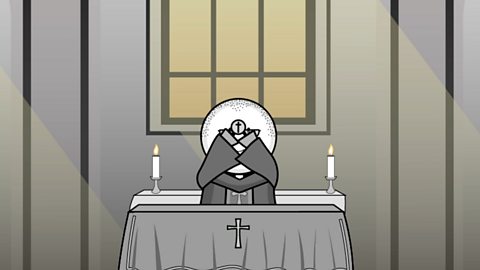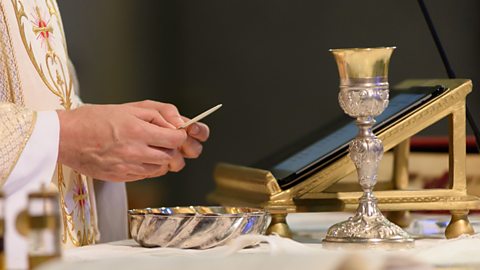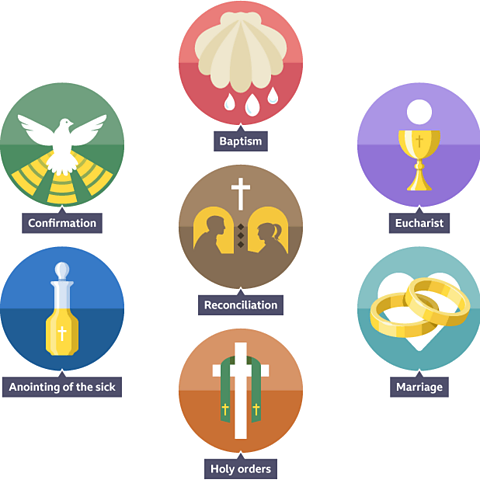Simon and Sarah discuss the role of Mass and of the sacraments in Catholicism
Why attend Mass?
Catholics believe that when they gather, they gather as God’s people. Jesus told his followers that he would be with them always. He said: "Whenever two or three of you come together in my name, I am there with you." (Matthew 18:20).
People go to MassA Roman Catholic service of worship that involves receiving Holy Communion. to give thanks and praise to God.
Mass consists of two main parts:
• the LiturgyLiturgy is public worship – the work of Christ and that of the Church, the Body of Christ. of the Word (focused on the BibleThe holy book of Christians split into two sections: Old Testament and New Testament.).
• the liturgy of the EucharistThe Christian service, ceremony, or sacrament commemorating the Last Supper. (Holy Communion).
- Liturgy of the Word:
Readings are taken from the Old and New Testaments.
The priest gives a sermon usually based on these readings. The Holy Spirit In Christianity, the Holy Spirit is the third person of the Trinity. helps people to understand what God is saying through the sermon.

- Liturgy of the Eucharist:
Catholics receive Holy Communion, on the hand or in the mouth, with profound respect because they believe Jesus is literally present.
The priest or eucharistic minister holds up the hostSacramental bread, also called Communion bread, Eucharist wafer, the Lamb or simply the host, is the bread used in the Christian ritual of the Eucharist. and says, ‘The Body of Christ,’ and the person receiving it says ‘Amen.’
This is a time of special prayer when people can talk to Jesus and thank him for his presence with them. Since the Second Vatican Council (1962-65), people are encouraged to take a full and active part in the celebration of Mass.
Mass is conducted in the local language.

The significance of receiving Holy Communion

Catholics believe, the bread and wine change and become the body and blood of Christ when the Priest says the words of Jesus.
This is known as the Consecration of the Mass. During the Consecration, the Risen Jesus becomes present under the appearances of bread and wine.
The term transubstantiation is used to explain the belief that the change has occurred.
Jesus referred to himself as the ‘Bread of Life’. Just like bread physically sustains and helps people to grow, Jesus sustains people spiritually and helps them to grow in the love of God.

The Mass and the Sacrifice of Jesus

The last meal Jesus ate with his disciples before he was crucified is referred to as the last supper. At that meal with the disciples Jesus took the bread, gave thanks, and said, ““Take and eat; this is my body.” Then he took a cup, and when he had given thanks, he gave it to them, saying, “Drink from it, all of you. This is my blood.” (Matthew 26:26-29)
Catholics believe that Jesus is present with them when they repeat his actions, and the Priest speaks his words. They are not simply remembering the sacrifice of Jesus; they are making it present again.
At Mass, Catholics remember the sacrifice of Jesus and join with the Risen Jesus as God’s people, who make sacrifices in order to live a life of love.

The seven sacraments of the Catholic Church
Sacraments are celebrations. They mark stages of life and are outwards signs and symbols which show that an inward gift from God has been given. There are seven sacraments in the Catholic Church.

| Baptism | Through this sacrament the person becomes a full member of the Church in order to grow in faith and belief. Baptism washes away original sin, begins a committed relationship with God and allows the person to receive eternal life when they die. This sacrament is necessary before receiving the rest. |
| Reconciliation | This sacrament allows someone to recognise that they have by their own actions separated themselves from a close relationship with God and that they need God’s forgiveness to cleanse their sins. It is an opportunity for Catholics to strengthen their relationship with God and encourages them to offer forgiveness to others in their lives. Through the Holy Spirit, the priest works to absolve the sins of the confessing Catholic. |
| Holy Communion | Catholics receive the Body of Christ during this sacrament which is the real presence of Christ. There is spiritual nourishment in receiving the bread and wine. Faith is strengthened and people grow closer to God. |
| Confirmation | As with baptism, confirmation leaves a spiritual mark on the person that cannot be removed. Confirmation is therefore important as it spiritually identifies a believer in Christ. It is the final sacrament of initiation and marks the growth of a Catholic into a mature member of the Church. It is a public declaration of the person’s faith as the baptismal vows are renewed and a declaration is made that they believe and will practise the Catholic faith. |
| Marriage | This sacrament celebrates a life-long commitment between two people, a man and a woman. The ceremony incudes the exchange of vows and rings, all symbolic of a couple’s faithful love for another. |
| Holy Orders | Priests receive this sacrament after many years of studying to become a member of the clergy. Only men can receive this sacrament and this means they can administer the sacraments to other Catholics as well as assume responsibility for the teachings given to the laity at Mass every week. |
| Anointing of the sick | This sacrament is offered to those who are ill and need God’s grace to help them recover. It may also be offered to those who have a terminal illness to prepare them for death. The Catholic receives spiritual strength in the form of Holy Communion and with the anointing of oil (chrism) to comfort them. The anointing is symbolic as Christ was anointed before he died. |
What challenges does the Church face today engaging with young people?

Making Mass relevant to life today.
Young people are interested in what the church has to offer such as community, faith formation, charity and mission but it needs to be delivered in an appealing way.
Ensuring that challenging topics are addressed and not ignored such as same-sex marriage, sex before marriage and embracing the LGBTQ+ community.
The need to be more inclusive of other faiths and ethnicities.

Quiz time!
More on The Christian church
Find out more by working through a topic
- count2 of 4

- count3 of 4

- count4 of 4
